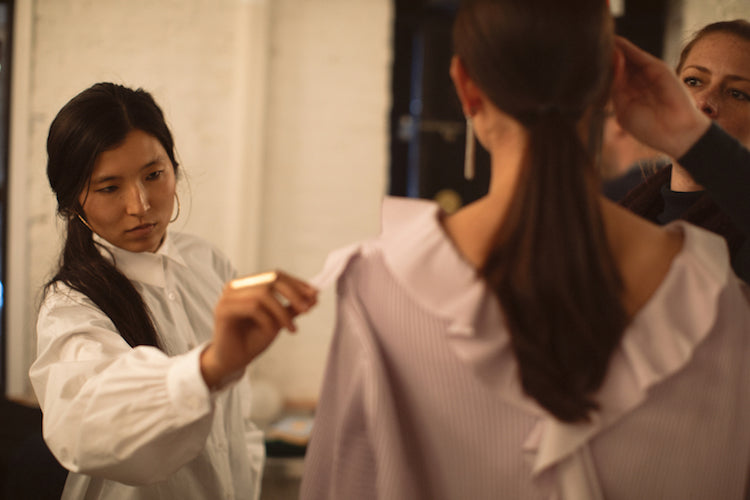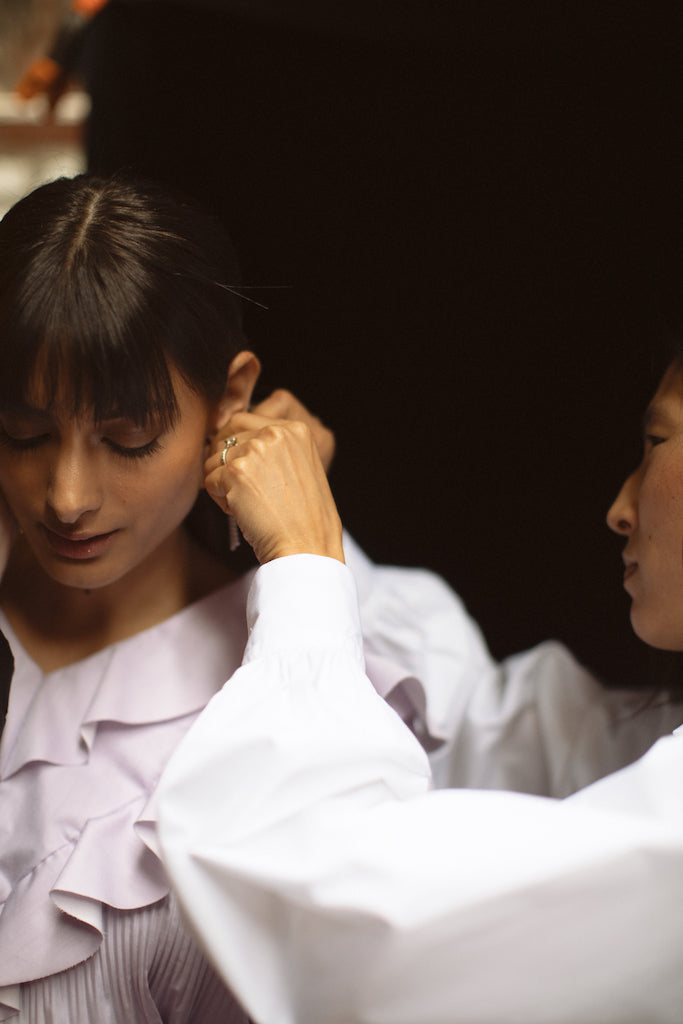Althea:You recently moved to NYC to pursue fashion. What you were doing just before you moved here?
Terumi:I’m from California, and before I moved to New York I was working at a global design company called IDEO in San Francisco. I ended up there after working for a super small design startup in Los Angeles, where I was doing everything from personal assisting to production to social media. It was my first time in a creative industry and I thought it was so cool; I need to work with designers. When I moved from LA to San Francisco I applied to IDEO and started a job on their marketing team. I needed to be in that creative environment; it’s very collaborative and you’re around a bunch of artists. I was doing project management, and I also managed the speakers program and did matchmaking for conferences.
A:It’s pretty amazing that you got a job at IDEO. I come from that world too, so I know how difficult it is to get a job there. It's like the rockstar place to work.
T:I will be totally honest; it took two tries. The first time I interviewed, I had just gotten back from a climbing trip in Europe. I was totally in “hippie granola” mode. You feel invincible when you come back from those climbing trips, but your brain gets a little bit mushy. Your brain shifts to a more primitive, instinctual way of thinking. I had not spoken intelligently or in non-climbing lingo for three weeks. I got off the plane totally jetlagged and went straight to this interview. I thought I was crushing it but I wasn't making any sense; I totally botched it.
Then I applied a second time two years later and it ended up working out. In between I was working at the start up in LA, and I guess I would say I was the woman that wore many hats. I gained a lot of experience and was also super humbled. I understood how much more I needed to learn to get to working at IDEO. I needed that experience.
My first interview was with the Chief Marketing Officer. I was so intimidated by this woman and her incredible curriculum vitae. I remember exactly what I wore. I felt that I needed to show who I was; even though this was an interview, I wanted to be me in all my colors. I had purchased these amazing silk, pink- and gold-printed pants. It was like a party on the bottom and then business on top. I found this Theory pantsuit, and I wore the blouse and this very proper blazer, with a crazy headband thing. There was a lot going on but it was very authentically me. She told me after the fact: “as soon as you walked into the room wearing what you were wearing, you were hired.” Of course I went through the whole round of interviews, it was like six or seven interviews, but I guess you could say that my outfit got me the job.
San Francisco is not a fashion capital by any means, but I used to call IDEO “the oasis.” People care so much about aesthetic, and also about sustainable fashion, so I was introduced to a bunch of new perspectives on fashion. There were a lot of European designers, so I saw a lot of Scandinavian influence and Italian influence. I got to see a lot of cool outfits and be around a lot of creative people in general, and that’s when I realized that I needed to continue being in this creative space. But even though this was very close to what I wanted to do, I was still approximating. There was still something missing.
I started freelance styling for fun. I had no idea what I was doing, but I started to put together shoots. I wanted to create art. I started doing it for fun with friends, and I would tag Goodwill in my photos [on Instagram]. Goodwill ended up sending me a direct message saying: “we love your stuff, we see you in our stores all the time, will you work with us?”
I started producing shoots for them for social media and doing small campaigns and hosting events with them, all styling from their warehouses and stores. It was super scrappy, but so much fun. I was picking the photographer, and I was picking models who were not professional models. I care a lot about representation; I was featuring women and men that wouldn’t usually be featured in a fashion campaign.
A:What does that mean?
T:People who weren't signed with an agency and didn’t fit the more traditional and old-school standard of beauty, maybe not five-nine, thin, and white. I really tried to push that limit.
I would create art with what I could find at Goodwill, and I loved that challenge. Fashion started to become really personally meaningful. I loved finding things that other people had thrown away and creating something beautiful out of those items that other people thought were ugly or not wearable anymore.
When my partner and I decided to move to New York, I figured it was time to take the leap. I left the nine-to-five, which was really more like an eight-to-eight and I loved it, but it was time to leave and pursue my own thing. That's how I ended up here, styling secondhand in New York City.
A:How does what you learned at IDEO affect how you approach your creative projects and styling?
T:There are three huge things that I took away from IDEO:
The first one was, I didn’t have the kind of a female mentor that I wanted until I got to IDEO. I worked on a team of 90% women, the most badass women in all senses of the word. They were really educated and brilliant, but also curious about the world, travel, athletic, artistic, mothers, and somehow manage to do it all because they were so passionate and put so much heart into what they do on a regular basis. As soon as I got there, I was like this is exactly what I need, I need a model for how to navigate my own career path and not compromise on things that I also care about, like spending time outside, caring about my family, and having a social life. IDEO as a business itself is a very socially- and environmentally-conscious company. It kept showing me that there is a way to do what you want to do without compromising who you are and what you want. I found really strong female empowerment and leadership.
The second thing was: one of my mentors, Susan O'Malley, said “Serendipity is deaf to silent intentions.” The point is that if you don't put yourself out there, serendipity doesn't happen. I had this light bulb moment: I had been admiring all these people who seem like things just fall into their laps, things just work, and the universe helps them actualize their dreams. I thought: “what am I doing wrong?” I realized that if you don't put your passions out there, serendipity doesn't happen, and the moment you do people are attracted to that energy and want to help you – you're getting inspired by other people and networking more.
The third lesson is from the former CEO, Tim Brown, who said: “if you want to increase your rate of success, you have to double your rate of failure.” That's also just a Silicon Valley mindset, but it’s important to make a ton of mistakes. It's okay if you botch a bunch of interviews. It's okay if you shoot a bunch of stuff that is totally unusable because you're learning from it somehow. It's getting you closer to your goal.













